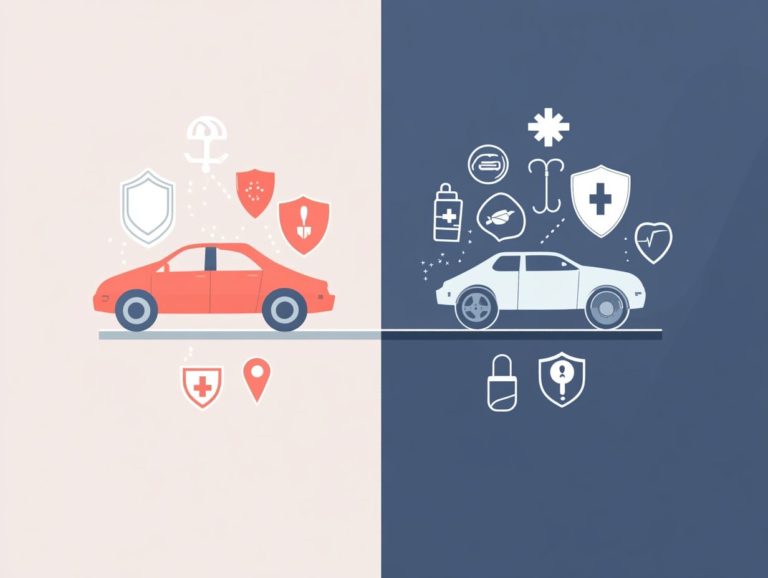The Role of Coverage in Financial Planning for Drivers
When it comes to financial planning for drivers, understanding coverage is essential. Coverage acts as your safety net against unforeseen incidents on the road, providing you with a way to keep your money safe in the event of accidents or damages.
This guide breaks down the various types of coverage like liability, collision, and comprehensive while also exploring the factors that influence coverage rates. It offers valuable insights on assessing your personal needs and getting the most from your coverage.
Get ready to buckle up; this guide empowers you with the knowledge necessary to make informed decisions about your driving coverage.
Contents
- Key Takeaways:
- Understanding Coverage in Financial Planning for Drivers
- Types of Coverage for Drivers
- Factors Affecting Coverage Rates
- How to Plan for Coverage as a Driver
- Maximizing Coverage Benefits
- Frequently Asked Questions
- What is the role of coverage in financial planning for drivers?
- What types of coverage are important for drivers in financial planning?
- Why is liability coverage important for drivers in financial planning?
- How can collision coverage benefit drivers in financial planning?
- What is the purpose of comprehensive coverage for drivers in financial planning?
- Why is uninsured/underinsured motorist coverage important for drivers in financial planning?
Key Takeaways:

- Coverage protects you from financial risks on the road.
- Liability, collision, and comprehensive coverage are your main options.
- Your driving history, vehicle type, and location can affect your rates.
Understanding Coverage in Financial Planning for Drivers
Understanding coverage for fleet drivers in financial planning is crucial. It goes beyond just liability and collision; it includes keeping your money safe and managing risks.
You should recognize the different types of insurance available to you, serving as a safety net against unforeseen events. This ensures that your financial planning is comprehensive, covering health insurance, life insurance, and property insurance tailored to your unique situation.
Taking this multifaceted approach not only enhances your risk management but also aligns with the ultimate goal of achieving long-term financial well-being.
What is Coverage and Why is it Important?
Coverage refers to the protection you gain against financial losses and liabilities that may arise from unforeseen events. It is a vital part of effective financial planning. Understanding the diverse insurance products available, such as health insurance and life insurance, is key to reducing risks and ensuring your financial security.
These policies are essential in shielding you and your family from unexpected financial burdens. For instance, health insurance helps cover medical expenses, significantly reducing the risk of crippling debt due to healthcare costs.
Life insurance offers financial support to your dependents in the unfortunate event of your untimely demise, ensuring your loved ones can maintain their standard of living.
Liability insurance, on the other hand, acts as a safeguard against claims stemming from injuries or damages inflicted upon others, giving you peace of mind in today s litigious world.
Having adequate coverage enables you to navigate life s uncertainties with confidence, knowing you re prepared for whatever may come your way.
Types of Coverage for Drivers
As a driver, grasping the array of coverage options available to you is essential for making informed decisions that protect your assets while providing peace of mind against the financial risks associated with driving.
The insurance landscape features several types of coverage, including liability insurance, collision coverage, and comprehensive coverage. Each serves a distinct purpose and addresses various aspects of your financial protection.
Liability Coverage
Liability coverage is a vital form of insurance that protects you from financial losses caused by damages or injuries to others in an auto accident. It’s an important part of your insurance for every driver.
This policy helps reduce your personal liability, allowing you to meet your coverage needs without straining your finances. It covers medical expenses, property damage, and legal fees from claims, acting as a safety net during tough times.
Imagine the confidence of knowing you’re protected against the potentially catastrophic costs of a serious incident. Without adequate liability coverage, you could face overwhelming debt or even bankruptcy.
Securing a strong policy protects your assets and boosts your financial stability, letting you focus on what truly matters ensuring your safety and the safety of others on the road.
Collision Coverage

Collision coverage is insurance that helps pay for repairs if your car hits something, like another vehicle or an object. It’s crucial for anyone looking to protect their investment, especially in areas known for heavy traffic or accident rates.
With collision coverage, you can relax knowing that you can repair your vehicle without financial strain, no matter who is at fault. It works well with comprehensive coverage, which protects against non-collision incidents, including theft and natural disasters.
By choosing collision coverage, you gain a financial buffer for both daily commutes and long trips. Understanding how these insurance components work together helps you make informed decisions, ultimately enhancing your overall protection on the road.
Comprehensive Coverage
Comprehensive coverage is your insurance ally, providing financial protection against non-collision incidents like theft, vandalism, or natural disasters. This policy offers a broader safety net for your valuable assets, enhancing your financial security.
Unlike basic liability coverage, comprehensive insurance covers a wide range of risks that could cause significant financial setbacks. For example, if a tree unexpectedly falls on your vehicle or if your car is stolen, comprehensive coverage helps ease the burden of repair or replacement costs.
When you combine this coverage with liability and collision insurance, you create a strong shield against various uncertainties on the road. Understanding coverage for uninsured vehicles enhances this well-rounded strategy, bringing you peace of mind and improving your overall financial health, preparing you for whatever challenges life throws your way.
Factors Affecting Coverage Rates
Several factors influence coverage rates for drivers, with location and driving history being key determinants of insurance premiums, especially when considering coverage for self-driving cars.
Understanding these elements enables you to make informed decisions that enhance your financial planning and minimize risks, ultimately leading to lower coverage costs.
Don’t wait until it’s too late secure your coverage today!
Location and Driving History
Your location and driving history are important factors in determining your coverage rates. Insurance companies assess risk based on these elements.
If you live in a bustling urban area, you can expect higher insurance premiums than someone in a tranquil rural setting. A clean driving record usually means better rates for you.
Statistics show urban drivers can pay up to 30% more for insurance than those in less populated areas. This highlights how location affects perceived risk.
Maintaining a solid driving history lowers your premiums and gives you leverage in negotiations with insurers. Safe driving protects you on the road and enhances your financial planning.
This proactive mindset can lead to significant savings on premiums over time. It cultivates responsibility and financial foresight key qualities in today s competitive insurance landscape.
Vehicle Type and Usage
The type of vehicle you own and how you intend to use it play a significant role in determining your coverage rates. Insurers often look at closely the make, model, and safety features of your vehicle to assess associated risk factors.
A sports car typically incurs higher insurance premiums than a family sedan due to its performance capabilities and the financial risks involved.
If you own a commercial vehicle, like a delivery van or truck, you can expect different rates. These vehicles have a higher likelihood of being involved in accidents or incurring damages.
For instance, a compact car designed for city commuting usually has lower insurance costs compared to an SUV made for off-roading adventures, which introduces unique hazards.
Understanding these variations is essential for planning your budget. This knowledge helps you choose vehicles that align with your financial goals while ensuring adequate protection.
How to Plan for Coverage as a Driver

Planning for coverage as a driver requires a thoughtful strategy. Start by assessing your personal coverage needs alongside your budget constraints. This approach allows for informed decisions regarding your insurance options.
By comparing rates and policies, you can enhance your financial planning and choose the most suitable coverage to safeguard against potential risks.
Assessing Personal Needs and Budget
Assessing your personal needs and budget is a crucial step in your coverage planning journey. This lets you tailor your insurance policies to fit your unique financial security requirements.
Consider all relevant financial circumstances, including your current income, expenses, and any existing debts. Analyzing these factors helps you determine how much you can realistically allocate for insurance premiums without compromising essential needs.
Setting clear financial goals is equally important. Whether you re saving for retirement, aiming for that dream home, or preparing for unexpected emergencies, each goal will shape the type and amount of coverage you ll need.
Utilizing a straightforward budgeting tool or spreadsheet can be immensely helpful. It allows you to track potential premiums against your overall budget, ensuring your chosen coverage integrates seamlessly with your financial plan.
Comparing Rates and Policies
Comparing rates and policies is crucial if you’re aiming to optimize your insurance coverage while keeping costs in check. This process helps you identify the best options tailored to your unique circumstances.
Collaborating with a financial advisor can streamline your journey. They ensure you receive precise insurance quotes customized to your needs.
Look into various coverage options and understand the subtleties of different policies to make informed decisions. A financial advisor makes things easier to understand by helping you prioritize key factors such as deductibles (the amount you pay out of pocket before insurance kicks in), coverage limits, and additional benefits, providing you with a well-rounded evaluation.
Investing time in thorough research can lead to substantial savings. This enables you to uncover discount opportunities and compare premium rates across different providers. You ll gain insights into the long-term implications of your chosen coverage, ultimately enhancing your financial security and providing you with peace of mind.
Maximizing Coverage Benefits
Maximizing coverage benefits is your goal as a driver. This ensures your insurance products effectively address your unique needs while offering optimal financial protection, particularly by understanding coverage limits for high-risk drivers.
By exploring the details of your policies, you can leverage your coverage to safeguard your assets and enhance your financial planning.
Tips for Making the Most of Coverage
To truly maximize your insurance coverage, embrace practical tips that deepen your understanding of your insurance products and policies. Prepare yourself to tackle life’s unexpected twists and turns.
Taking a proactive stance enhances your financial planning and strengthens your security against various risks.
Regularly reviewing your policy can reveal potential gaps in coverage or opportunities for more competitive rates. Familiarize yourself with specific terms and conditions to navigate claims easily, significantly reducing the risk of being caught off guard.
Keeping open lines of communication with your insurance agents is crucial. These professionals can offer tailored advice, clarify uncertainties, and suggest customized policies that align with your needs. Engaging with your provider builds trust and keeps you informed about any changes in coverage options, ensuring you remain well protected.
Frequently Asked Questions

What is the role of coverage in financial planning for drivers?
The role of coverage in financial planning for drivers is to protect them from unexpected financial expenses resulting from accidents, damages, or injuries while driving.
What types of coverage are important for drivers in financial planning?
Important types of coverage for drivers in financial planning include liability coverage, collision coverage, comprehensive coverage, and coverage in rental car agreements, as well as uninsured/underinsured motorist coverage.
Why is liability coverage important for drivers in financial planning?
Liability coverage is crucial because it protects drivers from having to pay for damages or injuries caused to others in an accident where they are at fault.
How can collision coverage benefit drivers in financial planning?
Collision coverage benefits drivers by covering the cost of damages to their own vehicle in a collision, regardless of who is at fault.
What is the purpose of comprehensive coverage for drivers in financial planning?
The purpose of comprehensive coverage is to cover damages to a vehicle that are not caused by a collision, such as theft, vandalism, or natural disasters.
Why is uninsured/underinsured motorist coverage important for drivers in financial planning?
This type of coverage protects drivers in the event of an accident with a driver who does not have enough insurance coverage to fully compensate for damages or injuries.
Consider reviewing your policies regularly and consulting with a financial advisor to ensure you have the best coverage for your needs.






